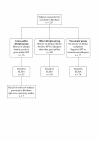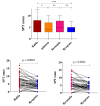Subtropical grass pollen allergens are important for allergic respiratory diseases in subtropical regions
- PMID: 22409901
- PMCID: PMC3320540
- DOI: 10.1186/2045-7022-2-4
Subtropical grass pollen allergens are important for allergic respiratory diseases in subtropical regions
Abstract
Background: Grass pollen allergens are a major cause of allergic respiratory disease but traditionally prescribing practice for grass pollen allergen-specific immunotherapy has favoured pollen extracts of temperate grasses. Here we aim to compare allergy to subtropical and temperate grass pollens in patients with allergic rhinitis from a subtropical region of Australia.
Methods: Sensitization to pollen extracts of the subtropical Bahia grass (Paspalum notatum), Johnson grass (Sorghum halepense) and Bermuda grass (Cynodon dactylon) as well as the temperate Ryegrass (Lolium perenne) were measured by skin prick in 233 subjects from Brisbane. Grass pollen-specific IgE reactivity was tested by ELISA and cross-inhibition ELISA.
Results: Patients with grass pollen allergy from a subtropical region showed higher skin prick diameters with subtropical Bahia grass and Bermuda grass pollens than with Johnson grass and Ryegrass pollens. IgE reactivity was higher with pollen of Bahia grass than Bermuda grass, Johnson grass and Ryegrass. Patients showed asymmetric cross-inhibition of IgE reactivity with subtropical grass pollens that was not blocked by temperate grass pollen allergens indicating the presence of species-specific IgE binding sites of subtropical grass pollen allergens that are not represented in temperate grass pollens.
Conclusions: Subtropical grass pollens are more important allergen sources than temperate grass pollens for patients from a subtropical region. Targeting allergen-specific immunotherapy to subtropical grass pollen allergens in patients with allergic rhinitis in subtropical regions could improve treatment efficacy thereby reducing the burden of allergic rhinitis and asthma.
Figures





Similar articles
-
Functional immunoglobulin E cross-reactivity between Pas n 1 of Bahia grass pollen and other group 1 grass pollen allergens.Clin Exp Allergy. 2011 Feb;41(2):281-91. doi: 10.1111/j.1365-2222.2010.03670.x. Clin Exp Allergy. 2011. PMID: 21231976
-
Specific IgE recognition of pollen allergens from subtropic grasses in patients from the subtropics.Ann Allergy Asthma Immunol. 2015 Mar;114(3):214-220.e2. doi: 10.1016/j.anai.2014.12.005. Ann Allergy Asthma Immunol. 2015. PMID: 25744907
-
Grass pollen allergens globally: the contribution of subtropical grasses to burden of allergic respiratory diseases.Clin Exp Allergy. 2014 Jun;44(6):790-801. doi: 10.1111/cea.12317. Clin Exp Allergy. 2014. PMID: 24684550 Review.
-
The molecular allergology of subtropical grass pollen.Mol Immunol. 2018 Aug;100:126-135. doi: 10.1016/j.molimm.2018.03.012. Epub 2018 May 31. Mol Immunol. 2018. PMID: 29778490 Review.
-
Bahia grass pollen specific IgE is common in seasonal rhinitis patients but has limited cross-reactivity with Ryegrass.Allergy. 2005 Feb;60(2):251-5. doi: 10.1111/j.1398-9995.2005.00663.x. Allergy. 2005. PMID: 15647049
Cited by
-
The macroecology of airborne pollen in Australian and New Zealand urban areas.PLoS One. 2014 May 29;9(5):e97925. doi: 10.1371/journal.pone.0097925. eCollection 2014. PLoS One. 2014. PMID: 24874807 Free PMC article.
-
Relative Abundance of Alpha-Amylase/Trypsin Inhibitors in Selected Sorghum Cultivars.Molecules. 2020 Dec 17;25(24):5982. doi: 10.3390/molecules25245982. Molecules. 2020. PMID: 33348658 Free PMC article.
-
Differences in grass pollen allergen exposure across Australia.Aust N Z J Public Health. 2015 Feb;39(1):51-5. doi: 10.1111/1753-6405.12325. Aust N Z J Public Health. 2015. PMID: 25648730 Free PMC article.
-
Molecular biomarkers for grass pollen immunotherapy.World J Methodol. 2014 Mar 26;4(1):26-45. doi: 10.5662/wjm.v4.i1.26. eCollection 2014 Mar 26. World J Methodol. 2014. PMID: 25237628 Free PMC article. Review.
-
A Single Multiplex CytoBas Assay Incorporating Eight Major Components for Accurate Detection of Allergen Sensitization in Asthma and Allergic Rhinitis.Allergy. 2025 Apr;80(4):1047-1059. doi: 10.1111/all.16513. Epub 2025 Mar 7. Allergy. 2025. PMID: 40052465 Free PMC article.
References
-
- Scala E, Alessandri C, Bernardi ML, Ferrara R, Palazzo P, Pomponi D, Quaratino D, Rasi C, Zaffiro A, Zennaro D. et al.Cross-sectional survey on immunoglobulin E reactivity in 23 077 subjects using an allergenic molecule-based microarray detection system. Clin Exp Allergy. 2010;40:911–921. doi: 10.1111/j.1365-2222.2010.03470.x. - DOI - PubMed
-
- Walls RS, Heddle RJ, Tang ML, Basger BJ, Solley GO, Yeo GT. Optimising the management of allergic rhinitis: an Australian perspective. Med J Aust. 2005;182(1):28–33. - PubMed
LinkOut - more resources
Full Text Sources

